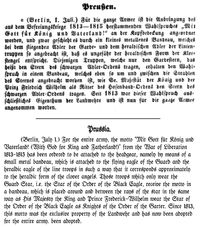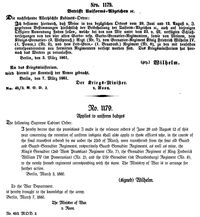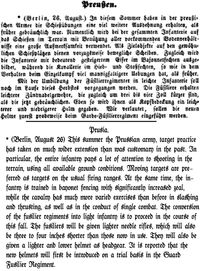10.05.1860:
Introduction of the banner "Mit Gott für König und Vaterland“ on the eagle plate, in memory of the Wars of Liberty against Napoleon.
With the reorganization of the army in the 1860s, and the accompanying formation of new regiments, many officers were transferred to these new regiments. With the AKO of 12.8.1860 the officers, who were transferred from the 1st to the 3rd Guards Regiment, were allowed to continue wearing their old helmets with the white fittings.
According to the AKO of 3.3.1861 and 30.10.1866, the same applied to the Guards, the Line Grenadiers and the officers whose old regiments had inscriptions on their helmets, but they had to take off their hairbrush if the new regiment did not wear one.
04.11.1860:
Introduction of the M60 helmet. In 1860, the military leadership changed the training guidelines, hoping to further improve the soldiers' fighting ability. In the process, it became apparent that the burden placed on infantrymen by the heavy equipment was generally too high and that a reduction in the weight of the same was urgently needed. Thus it came about that, although the Prince-Regent Wilhelm of Prussia, out of respect for tradition, as soon as actually advocated no further changes to the uniforms, a new packing system and an only slightly lighter helmet were introduced:
- The helmet height was reduced again (about 2-3 cm) and was now about 26 to 28 cm. The helmet was about 8 Loth (1 Loth=16,67 g) lighter than the previous model and weighed 700 to 800 g.
- The spike was still about 10,5 to 12,5 cm high, the length of the hair plume was reduced to 30 cm.
- Due to the reduced helmetbody the eagle plate also needed to be reduced in height. It was now 12 to 12,5 cm high and was placed on the visor seam. The award ribbons of special regiments, which were still attached over the visor seam after the AKO of April 5th, 1843, were now placed at the height of the crown on the eagle's head or the tips of the wings.
- Some helmets were equipped with smaller cockades of 60 to 65 mm diameter, which were introduced for the cuirassier helmets. Officially, however, a 70-75 mm tin cockade continued to be worn on the leather helmet. This was for enlisted men unchanged a black fanned disc with white painted ring, officers and non-commissioned officers with portepee wore a two-piece cockade, with a silver affixed ring.
A first indication for the new helmet was already given in the AKO of August 4, 1860, which announced the reorganization of the Fusiliers into a light infantry. In this, the leadership still reserved changes to helmet and packing system, which were then generally introduced on November 4.
16.03.1861:
Because of the reduced helmet height, the lengths of the hair plumes also had to be adjusted. The length of the hair was to be maintained, but it should always end at the upper or lower edge of the front visor, depending on the type of weapon. So to achieve this, the only thing left to do was to adjust the funnel length.









